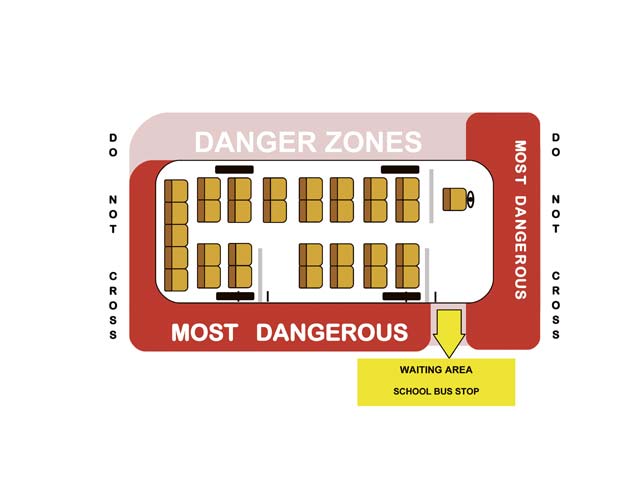With school starting Aug. 28, officials remind parents and students to reduce children’s risk for accidents and injuries by ensuring the following safety actions:
- Look at and know your children’s route to and from the bus stop.
- Show your children how to go safely to and from the bus stop using hands-on instruction. Cross streets only at designated crossings; do not cross the street between parked cars.
- Review the five safety rules listed later in this article with your children. Follow up and reinforce these rules.
- Stress good behavior and safety on the bus. Students must present his or her bus pass to the driver while boarding the bus.
- Report any safety or security concerns to the school bus office.
Additionally, children, particularly in kindergarten through second grade, need your supervision to keep them safe. Take them to and from the bus stop and wait with them until they have safely boarded the bus. When they return from school, meet them on the same side of the street at the bus stop. Do not wait in a parked car or building, and do not allow your child to come to you.
Important facts you need to know:
- In Europe, traffic does not stop for loading and unloading school buses.
- Children are at the greatest risk for accidents and injuries going to and from the bus stop.
Remember these bus safety ‘do’s’ and ‘don’ts’
Meeting children at the bus stop, parents:
DO …
- Wait on the same side of the street as the bus stop.
- Go to your child at the bus stop.
DO NOT …
- Wait in a parked car or in a building.
- Wait across the street from the bus stop.
- Allow your child to come to you.
Board the bus without proper authority (only registered students, bus driver, security attendant and school officials are authorized to board a school bus).
Bottom line: When you meet your child at the bus stop, please take charge of the situation. As the adult, you can reduce the risk to your child and control the danger.
Danger Zones:
Educate your child on the danger zones as shown on the picture below. We ask that you and your child take extra precautions when near a school bus.
Teach them to never cross in front of or behind a bus. Reinforce to your child that traffic in Europe does not stop for loading and unloading of school buses.
Stress good behavior on the bus — good behavior and safety go hand-in-hand. On or around buses, students must conduct themselves in accordance with the following school bus rules:
DODEA behavior standards for students:
- Obey the driver or adult.
- Enter and exit the bus safely, and always show your bus pass.
- Stay properly seated and use seat belts when available.
- Keep your hands, feet, and other body parts to yourself.
- Do not throw things.
- Put nothing out the window.
- Remain quiet and do not disturb the driver or others.
- No profanity, indecency, smoking, prohibited items or vandalism.
- Do not eat, drink or chew gum.
- Be responsible and be safe.
Five Basic Safety Rules for riding the bus:
- Be on time. Walk, do not run, to the bus stop.
- When waiting for the bus, take at least three large steps away from the curb.
- Take your seat on the bus and stay in it while the bus is moving. If there are seat belts, buckle up.
- When getting off the bus, take three large steps away from the curb and wait for the bus to depart before crossing the street.
- Never cross the street in front or behind the bus.
Ensure children know and use the safest route possible from home to and from the bus stop. Teach children how to safely cross the street and use pedestrian crosswalks and traffic-lighted intersections, where available. Students must present his/her bus pass to the driver while boarding the bus.
Ensure children wear clothing that is easily visible to motorists. You greatly improve the children’s visibility when you put reflective tape or devices on your children’s outerwear, book bags or other carried items.



